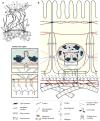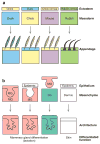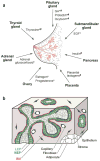Of extracellular matrix, scaffolds, and signaling: tissue architecture regulates development, homeostasis, and cancer
- PMID: 16824016
- PMCID: PMC2933192
- DOI: 10.1146/annurev.cellbio.22.010305.104315
Of extracellular matrix, scaffolds, and signaling: tissue architecture regulates development, homeostasis, and cancer
Abstract
The microenvironment influences gene expression so that the behavior of a cell is largely determined by its interactions with the extracellular matrix, neighboring cells, and soluble local and systemic cues. We describe the essential roles of context and organ structure in directing mammary gland development and differentiated function and in determining the response to oncogenic insults, including mutations. We expand on the concept of "dynamic reciprocity" to present an integrated view of development, cancer, and aging and posit that genes are like the keys on a piano: Although they are essential, it is the context that makes the music.
Figures



References
-
- Aggeler J, Ward J, Blackie LM, Barcellos-Hoff MH, Streuli CH, Bissell MJ. Cytodifferentiation of mouse mammary epithelial cells cultured on a reconstituted basement membrane reveals striking similarities to development in vivo. J Cell Sci. 1991;99(Pt. 2):407–17. - PubMed
-
- Allinen M, Beroukhim R, Cai L, Brennan C, Lahti-Domenici J, et al. Molecular characterization of the tumor microenvironment in breast cancer. Cancer Cell. 2004;6:17–32. - PubMed
Publication types
MeSH terms
Grants and funding
LinkOut - more resources
Full Text Sources
Other Literature Sources
Medical

